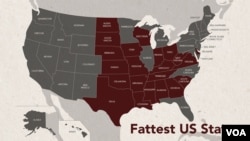All About America explores American culture, politics, trends, history, ideals and places of interest.
West Virginia (41%), Louisiana (40.1%) and Oklahoma (40%) are the states with the fattest populations in the nation, laying claim to the highest proportion of adults with a body mass index (BMI) of 40% or greater, according to the Centers for Disease Control and Prevention (CDC).
“The latest data from CDC is looking grim,” says Jamie Bussel of Robert Wood Johnson Foundation, a health-based philanthropic organization. “Twenty-two states had an adult obesity rate at or above 35%. And that was up from 19 states the year before. And when we look back a decade ago, no states had an adult obesity rate at or above 35%. So yes, clearly, when you look at the numbers, they’re not going in the right direction.”
In addition to West Virginia, Louisiana and Oklahoma, the 22 states with an obesity rate of 35% or higher are Alabama, Arkansas, Delaware, Georgia, Indiana, Iowa, Kansas, Kentucky, Mississippi, Missouri, Nebraska, North Dakota, Ohio, South Carolina, South Dakota, Tennessee, Texas, Virginia and Wisconsin.
The highest prevalence of obesity can be found in the Midwest and South, followed by the Northeast and the West. Obesity rates trended higher among Blacks, Hispanics, Native Americans and Alaska natives.
Every U.S. state had an obesity rate of at least 20%. The CDC calls additional support for obesity prevention and treatment “an urgent priority.”
“Obesity is a disease caused by many factors, including eating patterns, physical activity levels, sleep routines, genetics and certain medications,” said Karen Hacker, director of CDC’s National Center for Chronic Disease Prevention and Health Promotion, in a press release. “This means that there is no one size fits all approach. However, we know the key strategies that work include addressing the underlying social determinants of health such as access to healthcare, healthy and affordable food, and safe places for physical activity.”
Bussel says more robust federal food programs are necessary to help families living in poverty.
“In February of 2023, the USDA proposed updates to the school meals to align them with a diet that was [in line with] the latest dietary guidelines, and some of those changes include limits on added sugar, reductions in sodium levels, etc.,” she says. “We believe that those types of changes are really important changes that could improve students’ health and diet quality.”
There have also been changes to the WIC program, a federally funded supplemental nutrition program for women, infants and children, aimed at filling key nutritional gaps.
“A year ago in November, the USDA proposed updates to the WIC food package that will aim to help families purchase more nutritious foods,” Bussel says. “So again, these are federal-level policies that we believe are really important in helping ensure that all kids and families can thrive and be healthy and access good, high-quality food.”
Sheldon Jacobson, a professor of computer science at the University of Illinois, has studied obesity and says the government should invest more in public transportation to get people moving.
“We are such an automobile-centric society. We build our communities centered around suburbs,” he says. “We focus on driving rather than bicycling or walking or even public transportation and, as a result, that basically contributes to the fact that this inactivity is forcing people to gain weight, whether we like it or not, because we do less.”
The states and U.S. territories with the lowest rates of obesity are the District of Columbia (24.3%), Colorado (25%), Hawaii (25.9%) and Vermont (26.8%).






